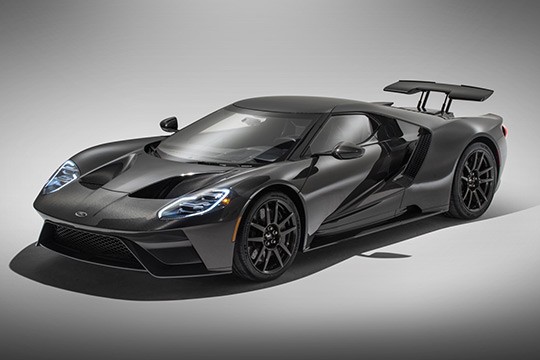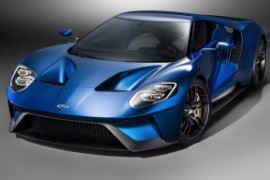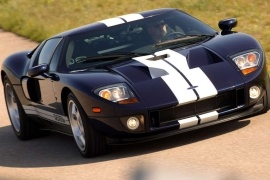FORD GT Models/Series Timeline, Specifications & Photos
First production year: 2004
Engines: Gasoline
Body style: Coupé (two-door)
2020 Ford GT has been unveiled and is ready to take your breath away. Literally. It has a fresh new look, and with it, an overall extended appeal.
The new GT comes with the same v6, 3.5-liter engine tuned with gallery-cooled pistons and higher-energy ignition coils. The engineering team also modified the engine cooling and airflow by fitting a lighter Akrapovic titanium exhaust that provides nine-pound weight savings over its predecessor while featuring that deeply profound, unmistakable vibrant sound emanating from the powerful Ecoboost engine. And with 13 more hp than its predecessor, the refreshed Ford GT is rounding up a colossal 660 hp. The 7-speed automatic gearbox remains untouched.
Ford will also introduce a Liquid Carbon GT version that comes with carbon fiber wheels, titanium lug nuts, six-point racing harness anchors, five interior options, five caliper colors and most importantly with the body of the car completely free of paint, leaving the model with a visible weaved exterior surface. The clear coat is designed to highlight the carbon fiber body, leaving the unmistakable feeling that Ford is constantly raising its game for its customers through this ultimate expression of innovation. On the updated Gulf Racing Heritage Livery, the carbon fiber wheels are now available for the first time instead of aluminum alloy.
Half a century after the magnificent 1-2-3 win at the 1966 LeMans race, Ford launched the second generation of the rejuvenated supercar Ford GT. The production started in December 2016 as a 2017 model year.
The new GT supercar features rear-wheel drive, a mid-mounted engine, and a two-door coupe body shell. It is propelled by a twin-turbocharged EcoBoost V6 producing more than 600 horsepower. It was packed with technology and covered in beauty. The sleek, aerodynamic bodywork has some particular details that can't be seen on other vehicles. The side pods, for instance, have the role to force the air to flow on the side of the body. Usually, car manufacturers are concerned about the above and underfloor turbulence. The GT managed to control the side turbulence.
Inside, the race-inspired cockpit hosts two bucket-seats, built with carbon fiber. They are light and slim. The SYNC3 infotainment unit was the most advanced connectivity system produced by Ford to date. Anchored by a carbon fiber passenger cell, the GT features aluminum front and rear subframes encapsulated in structural carbon fiber body panels. The windshield is made of Gorilla Glass, used for manufacturing smartphone screens.
The engine is a 3.5-liter twin-turbo V6 unit based on the Ford's IMSA Daytona Prototype for the endurance racing and it is rated at 647 hp. It is mated to a 7-speed dual-clutch transaxle transmission.
Ford tried to create a proper supercar for over three decades, but when the vehicle was finally unveiled, everyone knew that the wait was worth it.
The blue-oval badged brand made the GT celebrate its hundredth anniversary and outperform all other supercars on the market. Even though it didn’t tick all the boxes on that aspect, it managed to propel its wonder on wheels on the podium. The design team that penned the car took its inspiration from the original GT40 that won the 24 Hours of LeMans four times, beating Ferrari at its own game. And the 2004 GT did exactly the same, but in street clothing against the F360 that came from Maranello.
Caroll Shelby joined Ford once again to create the GT. The design team led by Camillo Pardo worked with help from J Mays, and the result was a modern interpretation of the LeMans winning car. Its front fascia showed a broad air intake in the bumper flanked by the scoops for the fog lamps. The headlights were flush with the bodywork, and the hood featured two oversized extracting vents.
From its profile, the car was four inches (100 mm) taller than the original 40-inch (1,106 mm) model. It was also longer and wider, so regular people could get inside. From its profile, the waved shapes of the waistline resembled the lines of the GT40 and those featured on the muscle cars of the mid-60s. Its big, six-spoke alloy wheels were wrapped in low-profile tires, like a proper supercar. Furthermore, a pair of air intakes placed behind the doors confirmed the fact that the engine was behind the cabin.
Ford went even further and created a clamshell that covered the engine bay where it placed the supercharged V8 engine, even though that could be seen through the glass above it. Finally, at the back, the rear fascia sported a pair of big and round taillights that echoed those installed on the 1964 GT40 MKI. In the middle, under the bumper, Ford installed the twin exhausts.
Thanks to the taller stance, the car had enough headroom even for tall occupants. But still, the doors cut a big chunk of the GT’s roof to help with ingress and egress. The automaker created a pair of seats that echoed those from the GT40 but with new materials and technology. As a result, the high-bolstered sports seats provided enough side support during high-speed cornering. Ford created a unique wide instrument cluster filled with seven dials. In front of the driver was the tachometer, while the speedometer was above the center stack, tilted to the one behind the wheel. On the center console, the automaker placed the gated gear stick and a few buttons and knobs.
Behind the cabin, Ford installed a supercharged 5.4-liter V8 engine and a six-speed manual gearbox. As expected, power went to the rear wheels only. Even if the automaker barely made a bit over 4,000 units of the GT, the car became an instant legend since it was the first proper American supercar.


